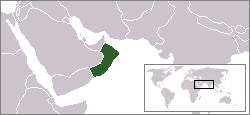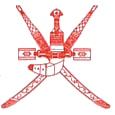Oman
Like a figurehead on a ship's prow, the shape of which it resembles, the Sultanate of Oman juts sharply from the southeast coast of the Arabian Peninsula into the Arabian Sea. The world's easternmost Arabian country, Oman shares desert borders with Saudi Arabia, the United Arab Emirates, and Yemen. The seacoast also includes the Gulf of Oman in the northeast, where the exclave peninsula of Musandam looks across the Strait of Hormuz to Iran.
| |||||
| National motto: none | |||||

| |||||
| Official language | Arabic | ||||
| Capital | Muscat | ||||
| Sultan | Qaboos bin Said Al Said | ||||
| Area - Total - % water |
Ranked 83rd 309,500 km² 0% | ||||
| Population - Total (2005) - Density |
Ranked 132nd 3,001,583 12.3/km² | ||||
| Independence | 1650 (expulsion of the Portuguese); 1971 from the UK | ||||
| National anthem | Nashid as-Salaam as-Sultani | ||||
| Currency | Rial | ||||
| Time zone | UTC+4 | ||||
| Internet TLD | .om | ||||
| Calling Code | 968 | ||||
Geography
Most of Oman (about 80%) is covered by a broad, rocky, barren, and mainly flat desert, the Rub al-Khali, the same vast expanse that dominates southern Saudi Arabia. Though Omani culture and customs have their origins in the tribal life that developed in this region, in the modern era only the occasional wadi, oasis, and camel are found there.
The Hajar Mountains in the northeast run parallel to the coast, with one peak reaching nearly 3,000 meters. They afford the country's only moderate temperatures in the summer from the intense heat that afflicts most of the Arabian Peninsula.
Oman's capital, Muscat, and the other main towns are all located along the narrow coastal plain. The climate on this strip of land differs from that of the interior desert only in levels of humidity. The coast in the unpopulated southwest is characterized by its towering cliffs.
The Musandam exclave (similar to Alaska's geographical relationship to the contiguous United States) commands a strategic site overlooking the choke point between the Gulf of Oman and the Persian Gulf (known by Arabs as the Arabian Gulf). It's a land apart from the Omani mainland in another sense, that being its terrain and economy. Its main prong thrusting into the Strait of Hormuz is jagged and flooded and has been compared to Norway and its fjords.
There is an additional exclave, though a smaller one, between Musandam and the rest of Oman, in the territory of the United Arab Emirates (UAE), which makes it an enclave as well as an exclave. And inside the Omani enclave is a tiny enclave of the UAE, the world's only such geographical oddity.
Omanis number about three million. In both population and size, the country is similar to Kansas.
History
In ancient history, the region of Oman was known principally for its copper mining, an activity still pursued in the present. Over the centuries the area was ruled intermittently by its transgulf neighbors, the Persians. Arab tribes moved into Oman, probably from Yemen, and had taken control of the area by the 7th century C.E. (The name Oman possibly derives from the name of a Yemeni tribe of that era.)
The people of the region converted to Islam within the prophet Muhammad's lifetime. By the middle of the 8th century, they were practicing a unique brand of the faith, Ibadhism, which remains the majority sect only in Oman. Ibadhism has been characterized as "moderate conservatism," with tenets that are a mixture of both austerity and tolerance.
The Portuguese occupied Muscat for a 140-year period (1508-1648), arriving a decade after Vasco da Gama discovered the seaway to India. In need of an outpost to protect their sea-lanes, the Europeans built up and fortified the city, where remnants of their colonial architectural style still remain.
The Ottomans drove out the Portuguese, but were pushed out themselves about a century later (1741) by the leader of a Yemeni tribe, who began the current line of ruling sultans. After one last, brief invasion a few years later by Persia, Oman was free for good of foreign occupying powers.
Isolated from their Arab neighbors by the desert, the Omanis became an economic power in the early 1800s, largely by using their position on the Indian Ocean and seafaring knowledge gained from the Portuguese to gain access to foreign lands. They took control of the coasts of presentday Iran and Pakistan, colonized Zanzibar and Kenyan seaports, and sent boats trading as far afield as the Malay Peninsula.
At this time, the country became known as Muscat and Oman, denoting two centers of power, not just the capital and the interior but also the sultan and the imam, the Ibadhist spiritual leader.
The British slowly brought about a collapse of Muscat and Oman's "empire" by the end of the 19th century without use of force. Through gradual encroachment on its overseas holdings economically and politically, they caused Oman to retreat to its homeland. In time Britain held such sway in Muscat and Oman itself that it became in effect, and later in fact, a British protectorate.
Having control of the country's military, the British helped subdue rebel tribesmen in the 1950s, driving most into Yemen. But the sultan's was a repressive regime, with laws forbidding numerous activities, including the building and even repair of people's own homes without permission. In 1970, almost certainly with British backing, he was overthrown by his son, the present ruler, Qaboos bin Said Al Said, and the country declared independence the following year as the Sultanate of Oman.
Qaboos is generally regarded as a benevolent absolute ruler, who has improved the country economically and socially. Oman has maintained peaceful ties on the Arabian Peninsula ever since ending another tribal rebellion in the southwest in 1982 by forging a treaty with Yemen.
In 1996 the sultan issued a decree promulgating a new basic law that clarifies the royal succession, provides for a bicameral advisory council with some limited legislative powers and a prime minister, and guarantees basic civil liberties for Omani citizens. Military bases in Oman were used (2001) by U.S. forces involved in ground raids against Afghanistan and Osama bin Laden. In 2003 the lower house of the advisory council was freely elected for the first time.
Politics
Main article: Politics of Oman
Chief of state and government is the hereditary sultan (Qaboos of Oman), who appoints a cabinet to assist him. In the early 1990s, the sultan instituted an elected advisory council, the Majlis ash-Shura, though only a small part of the Omanis were elegible to vote. Universal suffrage for those over 21 was instituted on 4 October 2003. Over 190,000 people (74% of those registered) voted to elect the 83 seats. Two women were elected to seats.
Although the sultan functions basically as an absolute Ruler, he has the approval of most of the Omanis: in his 30 years of government he has greatly improved the situation in the country. The governmental system is very gradually developing in the direction of some democracy.
Economy
Main article: Economy of Oman
The economy of Oman is dominated by its dependence on crude oil. A joint venture called IPC drilled a number of dry holes from 1956 onwards though the logistics of doing this were extremely difficult due to lack of any transportation infrastructure.
A lack of success, combined with worsening logistical problems and a glut of oil on the world market, led most of the partners to withdraw from the venture in 1960. Only Royal Dutch/Shell and Partex opted to remain in Oman to continue the search for oil. They struck oil at Yibal in 1962 at a site just some few hundreds of metres from the last dry hole.
In June 1967, the Compagnie Française des Pétroles rejoined the partnership by taking over 10% of Partex's equity share, resulting in the following shareholding: Shell 85%, Compagnie Française des Pétroles 10% and Partex 5%. The company changed its name to Petroleum Development (Oman). Shortly followed by the first export of Omani oil on 27 July 1967.
On 1 January 1974 the Government of Oman acquired a 25% shareholding in the Petroleum Development (Oman); half a year later they increased it to 60%, backdated to the beginning of the year. As a result foreign shareholding in PD(O) was now made up of Royal Dutch/Shell (34%), Compagnie Française des Pétroles (now Total)(4%) and Partex (2%).
In a Royal Decree of 15 May 1980, the company was registered as a limited liability company (LLC) under the name Petroleum Development Oman (without parentheses).
Today Oman produces around 700,000 barrels (110,000 m³) of oil per day and there have been significant discoveries of natural gas and development of liquefied natural gas terminals. Oil represents about 90% of Oman's exports.
The income generated was quickly deployed into building infrastructures of roads, schools, hospitals, water and electricity generating plants. All of this activity has made Oman a major success story for economic growth despite being the only oil-producing nation in the middle east that is not a member of OPEC.
Oman's economic performance improved significantly in 2000 due largely to the upturn in oil prices. The government is moving ahead with privatization of its utilities, the development of a body of commercial law to facilitate foreign investment, and increased budgetary outlays. Oman continues to liberalise its markets and joined the World Trade Organization in November 2000. GDP growth improved in 2001 despite the global economic slowdown.
Demographics
The majority of the Omanis are Arabs, although there is a sizable Baluchi minority (Iranian people). As in most other Arab countries, a large number of foreign laborers live here, mostly from India, Pakistan and Iran. The official language is Arabic, but the minorities speak their own languages. A non-Arabic Semitic language is spoken in Dhofar.
Islam is the predominant religion, mostly Ibadhi Muslims with a Sunni population in Dhofar.
Culture
Main article: Culture of Oman
Although Oman is a modern country, western influences are quite restricted; the Ibadhi form of Islam is very strict in comparison with Sunni Islam and Shi'a Islam.
Oman is famous for its khanjar knives(dagger).
Although Arabic is Oman's official language, there are still native speakers of dialects or offshoots of Southern Arabian, a Semitic language only distantly related to Arabic. However, even in Oman the dominant indigenous language is a dialect of Arabic.
External links
- Andy Carvin's Oman Photo Gallery
- Arab Gateway - Oman
- BBC News Country Profile - Oman
- CIA World Factbook - Oman
- LookSmart - Oman directory category
- Omani Ministry of Information
- Petroleum Development Oman
- Oman by Lonely Planet
- Library of Congress Country Study - Oman data as of January 1993
- Open Directory Project - Oman directory category
- Yahoo! - Oman directory category
Credits
New World Encyclopedia writers and editors rewrote and completed the Wikipedia article in accordance with New World Encyclopedia standards. This article abides by terms of the Creative Commons CC-by-sa 3.0 License (CC-by-sa), which may be used and disseminated with proper attribution. Credit is due under the terms of this license that can reference both the New World Encyclopedia contributors and the selfless volunteer contributors of the Wikimedia Foundation. To cite this article click here for a list of acceptable citing formats.The history of earlier contributions by wikipedians is accessible to researchers here:
The history of this article since it was imported to New World Encyclopedia:
Note: Some restrictions may apply to use of individual images which are separately licensed.
